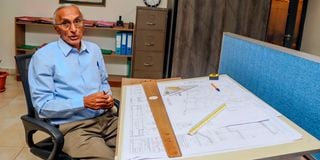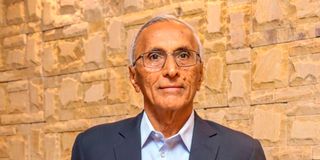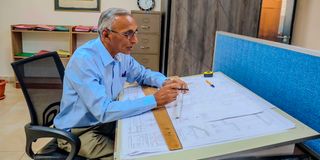
Mangat I.B. Patel (MIBP) Ltd Director Engineer Ratna Hirani during an interview at his office in Muthangari Drive, Waiyaki Way on August 12, 2024.
Just as a carpenter will look at a piece of furniture and own it, saying he or she saw the item progress from a mere idea to a solid product, Ratna Hirani looks at buildings in Nairobi and gets giddy.
“That’s my work,” the civil engineer buzzes while pointing at a building as we drive along Nairobi's Kenyatta Avenue.
Since 1973, he has been involved in the conceptualisation of various buildings in Nairobi and beyond.
In 1987, Lonrho House on Standard Street, Nairobi, mushroomed from a three-storey structure to the imposing glassy building it is today, thanks to an idea that came to Mr Hirani one weekend as he jogged.
A similar extension of Mega Plaza in Kisumu in 2014 was also his brainchild.
The threadbare Co-operative House stripped and shaken by the 1998 bomb blast, came back to life thanks to the work his firm did in 1999.
The I&M building at the heart of Nairobi and another along Limuru Road also have in their skeletons the ideas of Mr Hirani.
Mr Hirani is a director at Mangat IB Patel (MIBP) Consulting Engineers, where Water, Irrigation, and Sanitation Cabinet Secretary Eric Muuga was working before he was ushered into President William Ruto’s Cabinet.
Interviewing Mr Hirani feels like working with a high-end machine. He pulls questions from mid-air and gives just the right answers, buttering them with stories within stories and coating all this with humor. A nerd’s humor, you might add. He is the type that does not laugh at their own jokes, the type that says loud things without shouting.
We meet him witty and sharp after celebrating his 75th birthday the previous evening. He celebrated it at home with his family, he says, and he is pleased about how it went.
Marathons, hiking
He is 75 and athletic, full of running and sometimes mountaineering. He has run in every edition of the Standard Chartered Marathon except three (one was last year, when he had gone for hernia surgery). He summited Mount Kilimanjaro at the age of 62.
Deep into spirituality, which means he is a strict vegetarian, he wakes up by 4.30am every morning to do his chores. Yoga classes and running are part of his morning routines before he heads to the MIBP offices by 8.45am.
When it comes to running, he prefers doing it in solitude.
“I meditate when I run. I always run alone. I don’t look for company. People look for company; I don’t. I run alone, and I am thinking one step at a time and one breath at a time. So, that’s a philosophy in life I also adopt: one step at a time, one breath at a time. So that’s what I believe in life also,” says the engineer.
He joined MIBP in 1973 as a graduate engineer, being mentored by his seniors in the firm as he rose through the ranks to join the leadership side of things. MIBP was opened in 1968 by engineers Ishwarlal B Patel and HS Mangat, who are both deceased.
A civil engineer is something of a prefect in a construction project. Whereas the architect might want a trendy house with few inhibitions in the form of pillars and chic outer appearances, the civil engineer will want things to add up, not just look good. He or she will want a building that can hold its weight and hold people and their items stably forever.
“You see, a building is form and function: function first and form second,” says Mr Hirani.
That is why, in his line of work, he fights with architects every so often. Architects are the people who come up with sometimes otherworldly ideas about how a proposed building should be like. They are the ones who would recommend a building shaped as something or other. Civil engineers like Mr Hirani come with a wet blanket or something of the sort. And so, clashes ensue.

“We actually fight,” he says, adding that shortly before the interview, he was telling engineers under him not to cede too much ground regarding a proposal brought by an architect.
“I said, ‘Architects are not gods; they’re only architects.’ It has to work. They can show anything. But one important thing is that we must understand the intent: what is the intention? Intention and spirit are what a good structural engineer should understand: architect’s intention or client’s intention. Once you understand that, then you have to give him a structure which works,” Mr Hirani says. “It’s not the architect who is going to make it stand; it’s we (civil engineers).”
He then explains how things move from ideas to imposing buildings. This often starts with the owner, who approaches an architect over what they have in mind. The architect then works with engineers.
“We sit together and do preliminary designs and we say, ‘I need support here and here (like) columns here of this number.’ Then we work out the loads: what sort of loads are coming on the building in terms of dead loads, live loads, the restaurants, shops, supermarkets, whichever the building is supposed to be used for,” he says.
It is all calculations in this, and that is why Mr Hirani says someone who is good at mathematics and physics and who is good with drawings will thrive in civil engineering.
“We calculate all the loads, calculate sizes of columns, beams, slabs, all the other structure members, and then we’ll put it together on a drawing or on drawings and work out the foundation,” he says.
Before the project is approved and handed to the contractor to lump concrete and steel together to erect a structure, a lot of thinking is applied. The finishings, Mr Hirani says, are like makeup that come at the tail end of a construction.
“These maridadi things, you know the ‘lipstick’ and all that, that’s the last. But first is the function,” notes the former chair of the engineers chapter of the Architectural Association of Kenya.
At 75, he is not as into governance issues as he is into mentoring the younger crop of engineers at his firm. He believes that, much as technological advancement has spread its arm into various components of engineering, knowledge of the good old basics is key.
“When I started engineering, there were no PCs or computers. We were doing everything on the board. Drawings were done on the board, which I still do. Design calculations were also manual, and then the computer slowly started coming in. So, we started getting help from the computers, first in drawings, also in design, then software started being developed. We started using software. I have gone through all that but to be honest, if you ask me, I don’t know much about software,” he says.
Given his over four decades in the field, he has learnt to trust his intuition.
“My engineer comes and tells me, ‘This is the size I’m getting.’ I say, ‘Hang on. I don’t think that is correct.’ He says, ‘But my computer tells me this.’ I say, ‘To hell with the computer,’” says Mr Hirani.
In such scenarios, the sharp brain that secured him admission at top schools on the way to being a chartered engineer in the UK quickly sets in.
“I do quick calculations and I say, ‘No, it has to be something like this.’”
“But software is helping a lot. Things are happening much faster and more accurately. So, sometimes I blame technology. Why do I blame it? When it’s not being used correctly. So, it is the person behind the computer or the technology who matters. You are the master of the technology or the computers. Do not let that technology be your master. That’s important. And that’s what I tell my younger engineers,” Mr Hirani explains.
The other philosophy he imparts on greenhorns is the need to always do the right thing.
“If your mind is in engineering and professionalism and you’re doing the right things, then I think you don’t have to lose sleep (over any project),” he says. “Do the right design and make sure that it’s being implemented on site correctly by the contractors.”
With the lessons and mentorship he imparts, Mr Hirani is confident that Mr Muuga will deliver in his new role.
“I hope he keeps those values in his work there,” he says. “He was with us for about seven years and whatever values he’s got from this firm, he values them. That’s something good. How he carries forward and how he reforms the ministry and all that, hopefully he does it well, it’s up to him. But at least he knows he learnt the right values here.”

Mr Hirani, who came to Kenya at the age of 10, is a father of four: three sons and one daughter. All the sons are engineers (two are working at MIBP) while the daughter is an ecologist. One of his grandchildren is also pursuing engineering. Given that Mr Hirani’s father was a building contractor, this is a story of a construction dynasty in the making.
Marriage at 19
He got married at 19, and due to the fact that he has spent all his working life with the first firm that employed him, we put to Mr Hirani that his chip seems to be made of all loyalty.
“I think it’s patience also: (thinking that) if I continue like this, one day I will achieve something,” he says.
He believes MIBP gave him the right training opportunities so he could not be swayed elsewhere.
“Of course, the offers would come (from) somewhere else… I had opportunities to do other things,” he says. “I would not take it, because I was convinced that I was getting the right training and I had a future here in building the firm and then running the firm.”
When we ask him for the back story of some of the buildings he has constructed, he speaks excitedly. Lonrho House, which he worked on at the age of 40, is one of the most complex he has ever handled. The owner wanted his engineering firm to extend the three-storey structure without evicting the existing tenants or locking them out.
“It was a very uphill task,” he says as he remembers how IB Patel, his senior at MIBP, asked him to come up with a way to make that happen.
It was towards the end of the week and he remembers saying, “Let’s speak on Monday or Tuesday.”
Most complex job
As he was on a run that weekend, an idea struck him. He found a way of springing up a structure while letting the existing one be.
“While running, I was thinking about it, and I came back after my run to do some quick sketches,” he says. “I suggested an idea that we can do a building starting with a small one and then to a mushroom-like thing as we go up.”
When he presented the idea to the team that was to spearhead the construction, there was excitement.
“It came out that we did a good design and it was built,” he says.
What about the Co-operative House?
He says the reconstruction after the August 7, 1998 bomb blast involved rigorous tests that were done by an Israeli firm.
“There were limitations on the test equipment and all that. So, we got these guys from Israel to do those tests,” he says. “And then we designed how to reinstate it, test it and I think it was done very successfully.”
Then we ask him to share what life has taught him at 75. What wisdom can he share?
“I define wisdom as knowledge plus experience, and I think that wisdom becomes even more wisdom, if you impart your knowledge to others. By teaching others, you get more knowledge,” says the man who was behind Sagana State Lodge, Sarit Centre extensions, Bruce House Nairobi, Buruburu phase 2, 3 and 5, among many temples and buildings in Kenya.
For a man who volunteers to teach children, he practises what he preaches.
With a 2011 head of state commendation as one of the feathers on his cap, Mr Hirani has lived a life of ensuring soundness and enforcing stability. Of making sure places used by people are self-supporting — and this has to be mathematically proven. “Safe and sound” can never be more mathematical than when it is in Mr Hirani’s realm.









